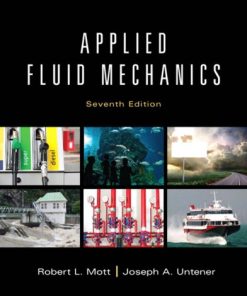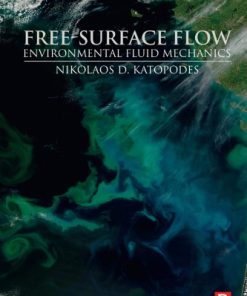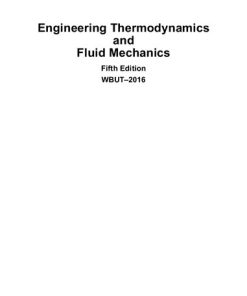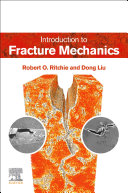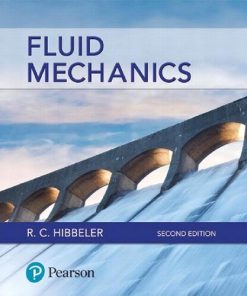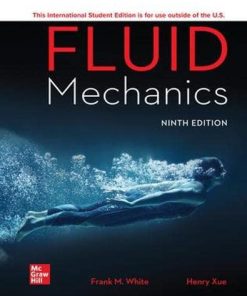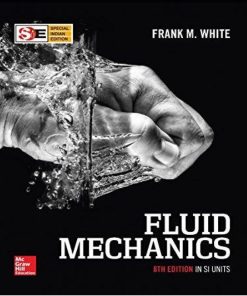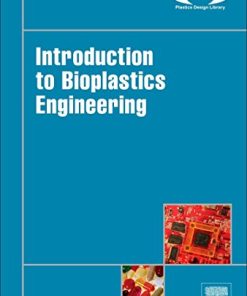Introduction to Engineering Fluid Mechanics 1st Edition by Marcel Escudier 0191030604 9780191030604
$50.00 Original price was: $50.00.$25.00Current price is: $25.00.
Introduction to Engineering Fluid Mechanics 1st Edition by Marcel Escudier – Ebook PDF Instant Download/DeliveryISBN: 0191030604, 9780191030604
Full download Introduction to Engineering Fluid Mechanics 1st Edition after payment.
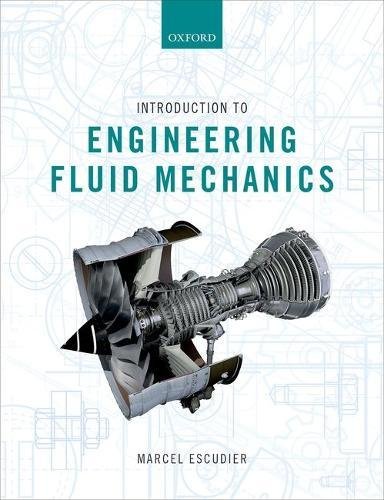
Product details:
ISBN-10 : 0191030604
ISBN-13 : 9780191030604
Author: Marcel Escudier
We inhabit a world of fluids, including air (a gas), water (a liquid), steam (vapour) and the numerous natural and synthetic fluids which are essential to modern-day life. Fluid mechanics concerns the way fluids flow in response to imposed stresses. The subject plays a central role in the education of students of mechanical engineering, as well as chemical engineers, aeronautical and aerospace engineers, and civil engineers. This textbook includes numerous examples of practical applications of the theoretical ideas presented, such as calculating the thrust of a jet engine, the shock- and expansion-wave patterns for supersonic flow over a diamond-shaped aerofoil, the forces created by liquid flow through a pipe bend and/or junction, and the power output of a gas turbine. The first ten chapters of the book are suitable for first-year undergraduates. The latter half covers material suitable for fluid-mechanics courses for upper-level students Although knowledge of calculus is essential, this text focuses on the underlying physics. The book emphasizes the role of dimensions and dimensional analysis, and includes more material on the flow of non-Newtonian liquids than is usual in a general book on fluid mechanics — a reminder that the majority of synthetic liquids are non-Newtonian in character.
Introduction to Engineering Fluid Mechanics 1st Table of contents:
1 Introduction
1.1 What are fluids and what is fluid mechanics?
1.2 Fluid mechanics in nature
1.3 External flows
1.4 Internal flows
1.5 Summary
2 Fluids and fluid properties
2.1 Fluids and solids
2.2 Fluid density ρ
2.3 Atoms, molecules, and moles
2.4 Perfect-gas law
2.5 Continuum hypothesis and molecular mean free path
2.6 Equation of state for liquids
2.7 Specific volume v, relative density σ, and specific weight w
2.8 Dynamic viscosity (viscosity) μ
2.9 Kinematic viscosity ν
2.10 Non-Newtonian liquids
2.11 Bulk modulus of elasticity K and compressibility
2.12 Speed of sound c
2.13 Vapour pressure pV, boiling, and cavitation
2.14 Surface tension σ and contact angle θ
2.15 Summary
2.16 Self-Assessment Problems
3 Units of measurement, dimensions, and dimensional analysis
3.1 Units of measurement
3.2 The International System of Units (SI)
3.3 Dimensions
3.4 Combining dimensions and combining units
3.5 The principle of dimensional consistency (or homogeneity)
3.6 Dimensional versus non-dimensional representation
3.7 Buckingham’s Π (pi) theorem
3.8 Sequential elimination of dimensions (Ipsen’s method)
3.9 Rayleigh’s exponent method
3.10 Inspection method
3.11 Role of units in dimensional analysis
3.12 Special non-dimensional groups
3.13 Non-dimensional groups as force ratios
3.14 Similarity and scaling
3.15 Scaling complications
3.16 Other Reynolds-number considerations
3.17 Summary
3.18 Self-Assessment Problems
4 Pressure variation in a fluid at rest (hydrostatics)
4.1 Pressure at a point: Pascal’s law
4.2 Pressure variation in a fluid at rest; the hydrostatic equation
4.3 Pressure variation in a constant-density fluid at rest
4.4 Basic pressure measurement
4.5 Mercury barometer
4.6 Piezometer tube
4.7 U-tube manometer
4.8 Effect of surface tension
4.9 Inclined-tube manometer
4.10 Multiple fluid layers
4.11 Variable-density fluid; stability
4.12 Deep oceans
4.13 Earth’s atmosphere
4.14 Pressure variation in an accelerating fluid
4.15 Summary
4.16 Self-Assessment Problems
5 Hydrostatic force exerted on a submerged surface
5.1 Resultant force on a body due to uniform surface pressure
5.2 Vertical component of the hydrostatic force acting on a submerged surface
5.3 Archimedes’ principle and buoyancy force on a submerged body
5.4 Hydrostatic force acting on a submerged vertical flat plate
5.5 Hydrostatic force acting on a submerged curved surface
5.6 Stability of a fully-submerged body
5.7 Stability of a freely floating body and metacentric height
5.8 Summary
5.9 Self-Assessment Problems
6 Kinematic description of fluids in motion and approximations
6.1 Fluid particles
6.2 Steady-flow assumption
6.3 Pathlines, streamlines, streamsurfaces, and streamtubes
6.4 No-slip condition and the boundary layer
6.5 Single-phase flow
6.6 Isothermal, incompressible, and adiabatic flow
6.7 One-dimensional flow
6.8 One-dimensional continuity equation (mass-conservation equation)
6.9 Average flow velocity V
6.10 Flow of a constant-density fluid
6.11 Summary
6.12 Self-Assessment Problems
7 Bernoulli’s equation
7.1 Net force on an elemental slice of fluid flowing through a streamtube
7.2 Acceleration of a fluid slice
7.3 Euler’s equation
7.4 Bernoulli’s equation
7.5 Interpretations of Bernoulli’s equation
7.6 Pressure loss versus pressure difference
7.7 Summary
7.8 Self-Assessment Problems
8 Engineering applications of Bernoulli’s equation
8.1 Wind-tunnel contraction
8.2 Venturi-tube flowmeter
8.3 Venturi-tube design and the coefficient of discharge CD
8.4 Other Venturi-tube applications
8.5 Orifice-plate flowmeter
8.6 Other differential-pressure inline flowmeters
8.7 Formula One racing car
8.8 Pitot tube
8.9 Pitot-static tube
8.10 Liquid draining from a tank
8.11 Cavitation in liquid flows
8.12 Summary
8.13 Self-Assessment Problems
9 Linear momentum equation and hydrodynamic forces
9.1 Problem under consideration
9.2 Basic linear momentum equation
9.3 Fluid-structure interaction force
9.4 Hydrodynamic reaction force
9.5 Summary
9.6 Self-Assessment Problems
10 Engineering applications of the linear momentum equation
10.1 Force required to restrain a convergent nozzle
10.2 Rocket-engine thrust
10.3 Turbojet-engine thrust
10.4 Turbofan-engine thrust
10.5 Flow through a sudden enlargement
10.6 Jet pump (or ejector or injector)
10.7 Reaction force on a pipe bend
10.8 Reaction force on a pipe junction
10.9 Flow through a linear cascade of guidevanes
10.10 Free jet impinging on an inclined flat surface
10.11 Pelton impulse hydraulic turbine
10.12 Summary
10.13 Self-Assessment Problems
11 Compressible fluid flow
11.1 Introductory remarks
11.2 Thermodynamics
11.3 Bernoulli’s equation and other relations for compressible-gas flow
11.4 Subsonic flow and supersonic flow
11.5 Mach wave and Mach angle
11.6 Steady, one-dimensional, isentropic, perfect-gas flow through a gradually convergent duct
11.7 Steady, one-dimensional, isentropic, perfect-gas flow through a convergent-divergent nozzle
11.8 Normal shockwaves
11.9 Perfectly expanded, underexpanded, and overexpanded nozzle flow
11.10 Summary
11.11 Self-Assessment Problems
12 Oblique shockwaves and expansion fans
12.1 Oblique shockwaves
12.2 Prandtl-Meyer expansion fan (centred expansion fan)
12.3 Supersonic aerofoils and shock-expansion theory
12.4 Summary
12.5 Self-Assessment Problems
13 Compressible pipe flow
13.1 Basic equations
13.2 Adiabatic pipe flow with wall friction: Fanno flow
13.3 Isothermal pipe flow with wall friction
13.4 Frictionless pipe flow with heat addition or extraction: Rayleigh flow
13.5 Summary
13.6 Self-Assessment Problems
14 Flow through axial-flow-turbomachinery blading
14.1 Turbomachinery (general)
14.2 Dimensional analysis and basic non-dimensional parameters
14.3 Linear blade cascade: Geometry and notation
14.4 Incompressible flow through a linear cascade
14.5 Compressible flow through a linear cascade
14.6 Rotor-flow velocity triangles
14.7 Euler’s turbomachinery equation for an axial-flow rotor
14.8 Compressible flow through an axial turbomachine stage
14.9 Degree of reaction Λ
14.10 Summary
14.11 Self-Assessment Problems
15 Basic equations of viscous-fluid flow
15.1 Equations of motion in Cartesian-coordinate form
15.2 Equations of motion in cylindrical-coordinate form
15.3 Boundary conditions
15.4 Non-dimensional form of the Navier-Stokes and continuity equations
15.5 Flow of a generalised Newtonian fluid
15.6 Summary
16 Internal laminar flow
16.1 General remarks
16.2 Poiseuille flow of a Newtonian fluid, hydraulic diameter, and Poiseuille number
16.3 Poiseuille flow through an axisymmetric cylindrical duct
16.4 Combined plane Couette and Poiseuille flow between infinite parallel plates: Couette-Poiseuille
16.5 Taylor-Couette flow
16.6 Poiseuille flow of generalised Newtonian fluids between infinite parallel plates
16.7 Viscometer equations
16.8 Summary
16.9 Self-Assessment Problems
17 Laminar boundary layers
17.1 Introductory remarks
17.2 Two-dimensional laminar boundary-layer equations
17.3 Flat-plate laminar boundary layer: Blasius’ solution
17.4 Wedge-flow laminar boundary layers: Falkner and Skan’s equation
17.5 von Kármán’s momentum-integral equation
17.6 Profile methods of solution
17.7 Aerofoil lift in subsonic flow
17.8 Summary
17.9 Self-Assessment Problems
18 Turbulent flow
18.1 Transitional and turbulent flow
18.2 Reynolds decomposition, Reynolds averaging, and Reynolds stresses
18.3 Turbulent-kinetic-energy equation and Reynolds-stress equation
18.4 Turbulence scales
18.5 Turbulence modelling
18.6 Two-dimensional turbulent boundary layers and Couette flow
18.7 Plane turbulent Couette flow and the Law of the Wall
18.8 Fully-developed turbulent flow through a smooth circular pipe
18.9 Surface roughness
18.10 Fully-developed turbulent flow through a rough-surface circular pipe
18.11 Minor losses in pipe systems
18.12 Momentum-integral equation
18.13 Flat-plate boundary layer
18.14 Boundary layers with streamwise pressure gradient
18.15 Bluff-body drag
18.16 Summary
18.17 Self-Assessment Problems
People also search for Introduction to Engineering Fluid Mechanics 1st:
introduction to chemical engineering fluid mechanics
introduction to chemical engineering fluid mechanics pdf
introduction to chemical engineering fluid mechanics solution manual
introduction to chemical engineering fluid mechanics deen
introduction to chemical engineering fluid mechanics solution
Tags: Introduction, Engineering, Fluid Mechanics, Marcel Escudier
You may also like…
Engineering
Physics - Mechanics: Fluid Mechanics
Engineering - Aerospace Engineering
Physics - Mechanics: Fluid Mechanics
Fluid Mechanics 2nd Edition by Russell Hibbeler 0134626055 9780134626055
Physics - Mechanics: Fluid Mechanics
Engineering - Aerospace Engineering




